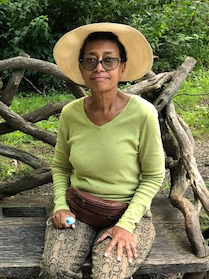
“When I walked into Pratt, well, first of all, it was placed in my head that that’s where I needed to be. And it was placed in my head by people who cared about me and who made sure that I’d be ready when I got there. So that’s the kind of mentorship and education I think that we need to prepare all of our children for, not just me and Pratt, but everybody.”
Renelda Higgins Walker
Education and Activism in the Desegregating South
Renelda Higgins Walker grew up in Louisville, Kentucky in the 1950s and attended a segregated Black school two years after Brown vs. Board of Education. Although she could have attended the white school which was closer, her parents chose the Black school. Renelda recalls that this decision was “probably the smartest thing our parents did was to send us to the Black school, which was 10 blocks away.” The school was “warm” and welcoming with teachers who lived close by and students who belonged to her church and Girl Scouts group. Renelda remembers that in second grade, all the students learned piano and “in the third grade we had art and we went to the symphony orchestra twice every year.” Her first involvement with the Civil Rights movement in the South was as a Brownie, when her mother led the troop in the “Nothing New for Easter” movement and subsequently the movement for open housing.
When Renelda was 11 or 12, the art teacher in her elementary school, Mrs. Hutchinson, encouraged her to become an artist. Renelda then attended a high school that was desegregating where she met a Pratt advocate, Mary Bernard:“she was an art teacher and she loved me.” But Renelda did not attend Pratt when she graduated because she had received a full scholarship to the University of Louisville, which was predominantly white. During her first or second semester, after she became involved in an office takeover with the Black Student Union, her scholarship was rescinded.
“One day we were looking at the front page of the New York Times. It had a picture of three Columbia students with berets and a rifle…. And they had taken over the administration building demanding Black students be brought into Columbia. Well, we looked at each other and there must have been about eight or nine of us. And we said, we could do that…I think it was maybe a week and a half of planning and we did the same kind of thing. We didn’t have weapons of any kind, but we did take over this one office at the University of Louisville.”
Art Education in the North
Renelda transferred to Pratt in 1969 where she studied photography, design, and illustration. She had her first child in 1970 and her second in 1972. She remembers the students who were involved in the Black Student Union and the Puerto Rican Student Union, “but my focus at this point was on my work, on my artwork, on school and my family.” She remembers taking a curating course at Pratt which gave her an opportunity to work with other students who would become part of the new wave of Black curators in the country, such as Claudine Brown, who became the Director of Education at the Smithsonian and became a close friend of Renelda’s after they graduated from Pratt.